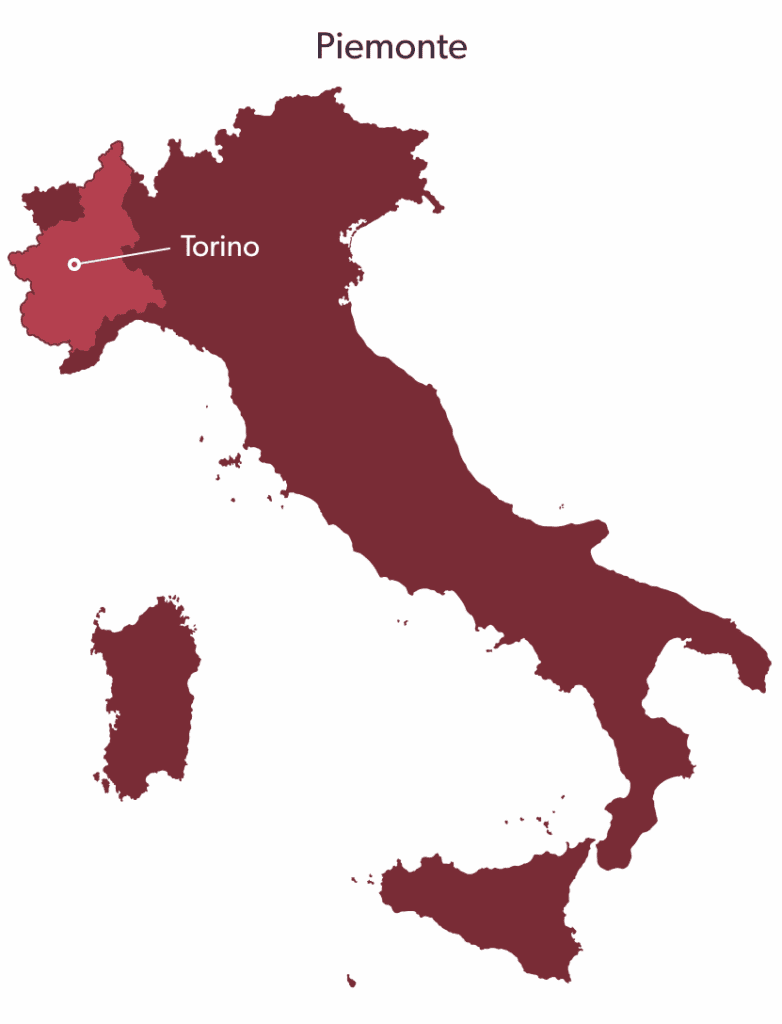Monferrato is a hilly area in the region of Piemonte between the provinces of Alessandria and Asti. It extends southwards starting from the right bank of the Po river up to the foot of the Ligurian Apennines mountains, on the border with the metropolitan city of Genoa and the province of Savona.
This area represents 300,000 hectares of nature crossed by streams, hills and vineyards. Depending on the season, the colours of Monferrato can change beautifully, the seasons also bring a change in the search for different tastes: from hunting for truffles, and collecting mushrooms and hazelnuts, to harvesting and tasting incredible wines.
The cuisine of Monferrato will delight you with its simple but special dishes based on local products. Its noble wines, such as Barbera d’Asti, Barbera del Monferrato, Dolcetto d’Acqui and its sparkling wines will also make any visit to this area particularly memorable and not one to miss!
This historical are of Piemonte, almost entirely included in the province of Alessandria and partly in that of Asti, is bordered by the Tanaro, Belbo and Bormida rivers and by the course of the Po river to the north. Together with the Langhe and Roero, Monferrato is part a UNESCO World Heritage site.
Its rolling hills are home to ancient castles that make the landscape unforgettable. Camino Castle is one of the most beautiful in Italy. It is located in a park of ancient trees and has been transformed into a luxury b&b where visitors can spend a unique night different from most tourist accomodations. Then there are the Palaeologi castles of Casale Monferrato and of Gabano. The Montemagno Castle of the Calvi di Bergolo Counts, in the province of Asti, has features to discover such as its Baroque entrance portal as a well an underground labyrinth which served as prisons. Or, if youre looking to sleep and spend the night as a king of queen , be sure to check our the Castello di Razzano.
This area is also known for its incredible land art, typically found among the area’s vineyards or its old abandoned chapels which are covered with beautiful murals done by internationally renowned artists. The territory is also covered by the BigBenches, which are public artworks of colourful giant benches known around the world.
Acqui Terme
Acqui Terme is an idyllic Piemonte village located in the province of Alessandria. It is a charming town in the south-eastern part of the upper Monferrato, on the left bank of the Bormida river at 156 meters above sea level. Its origins are very ancient and walking through its streets gives the impression that you have gone back in time. The oldest part is made up of Borgo Pisterna, adjacent to Borgo Nuovo and Borgo San Pietro; the three villages make up the center of the noble city.
The village of Acqui Terme and its fame is inextricably linked to its thermal springs. The most important springs are located in the Bagni district, where at the end of the fifteenth century a spa called Antiche Terme was built, it destroyed in the seventeenth century by a landslide and eventually rebuilt in 1687. Nearby there is also the Regina spa and a large swimming pool from 1927. Newer baths were built during the 19th century and named “New Baths”. Since 2000, in the village’s Piazza Italia, there are two monumental fountains called “delle Ninfe” and “delle Ninfee” which have not been in use since 2009 but have remained for their purely aesthetic value, becoming a flowerbed with colourful flowers and centuries-old olive trees.
Over the centuries, the original village saw constant spread of religious buildings including the three most important churches. The church of San Francesco located near the “Bollente” and is almost completely rebuilt in the neoclassical style in the mid-19th century. Originally it was joined to a Franciscan convent of which two beautiful fifteenth-century cloisters still remain today.
In the historic center of Acqui Terme we recommend a visit to the wonderful cathedral of Santa Maria Assunta built in the Romanesque style with a Latin cross plan, built in the 10th century and consecrated in 1067. Worth seeing is the church of San Pietro also called the church of the Addolorata , of early Christian origin, rebuilt in Romanesque style between the 10th and 11th centuries.
Some other beautiful historical places of great artistic and architectural importance to visit include the Piazza della Bollente, located next to Corso Italia, where visitors will find a octagonal marble shrine, with a thermal spring inside. Legend has it that newborn children of the area were immersed in this spring for a moment, if they remained alive they were called “sgaientò“, or scolded in English, this tradition was used to determine who was a true resident of Acqui Terme. On Piazza Levi you can visit two important civil buildings: the Town Hall built in the seventeenth century which became the town hall at the beginning of the twentieth century and the Robellini house built in the sixteenth century and rebuilt in the eighteenth century style. There is also a Civic Tower that overlooks Piazza della Bollente, it was built on the ancient city walls with a bell and a clock. Near the tower there is the ancient Jewish ghetto, the Episcopal Palace, the Hospital of Santa Maria Maggiore built in the 15th century, the Paleologi Castle founded in the 15th century and now home to the Municipal Archaeological Museum. Visitors can visit the museum’s numerous exhibits on display, mostly from the Roman times. This castle is now considered one of the “Open Castles” of Lower Piemonte.
THE WINES OF MONFERRATO
Monferrato is a predominantly agricultural area, especially focuses on the production of wine. This territy is known for precious and sought-after varieties which produce excellent wines. Among the most interesting include: Barbera d’Asti, Ruchè di Castagnole Monferrato, Nizza, Moscato d’Asti and Brachetto d’Acqui.
BARBERA D’ASTI
Barbera d’Asti is considered one of, if not the most interesting wine of the entire Piemonte region. Among its characteristics, this wine has an intense ruby red colour, a fruity smell with hints of rose, and a full and enveloping taste. The alcohol content of this red wine is 12.5% vol and must age for about 14 months, and only then can it be defined Superiore. Barbera d’Asti Superiore differs from the young Barbera, firstly its colour tends slightly more orange, its scent is less fruity and has hints of vanilla and spices with a more intense flavour and a great structure.
Barbera d’Asti can be presented in different ways: still (tranquillo), bubly (vivace) and superiore. The Barbera d’Asti Tranquillo goes well with savory first courses and second courses with meat. It should be served at a temperature between 16-18 ° C and goes well with tagliolini with sauce, agnolotti, tagliatele with meat sauce, lamb fricassee and aged cheeses. Vivace Barbera d’Asti is lighter and can be paired with more dishes, such as risotto with sausage, pappardelle with roast sauce, rice and quail. It also goes well with cooked meats such as cotechino, salamella, zampone, verzata with pork rinds, baked lamb, and grilled pork chops. It should be served at a temperature of 16 ° C.
Finally, we have Barbera d’Asti Superiore which, when aged, has great structure and balance and accompanies elaborate meat-based dishes.
RUCHE’ DI CASTEGNOLE MONFERRATO
Ruchè di Castagnole Monferrato DOCG originates from the black grape variety that bears the same name and is grown, in the territory of only seven municipalities in Asti: Castagnole Monferrato, and the villages of Montemagno, Grana, Portacomaro, Refrancore, Scurzolengo and Viarigi.
This medium-sized grape, rich in sugars and aroma precursors produces slightly aromatic ruby red wine, with notes of dried rose, violet and spices, and a taste reminiscent of ripe blackberries, raspberries and plums, with hints of spices such as black pepper. Overall, the taste is usually smooth and balanced.
Ruchè wine pairs well with local dishes, such as aged and blue cheeses and meat-based second courses, however it also pairs with dishes from the around the world which is one of the reasons for its success internationally. It’s softness and depth of its flavours make it easy to combine with foods rich in aromas and spices, such as ginger, and therefore with typical dishes of Asian cuisine, or spicy dishes and, even dishes based on tuna fish! The versatility of Ruchè in its food pairings therefore makes it a truly cosmopolitan wine.
BRACHETTO D’ACQUI
Brachetto d’Acqui, recognized as a DOCG wine in 1996, has the following characteristics: an intense red, ruby or purple colour; its scent is delicate and aromatic, and recalls the scents of ripe fruit and floral aromas, but it also has a musky component and an aromatic persistence, slightly almondy. As for the taste, this wine stands out for its sweetness and for its pleasant, delicate and soft flavour. In the sparkling version of Brachetto d’Acqui, it has brilliant and fine froth which distinguishes the wine, and is characterized by its great clarity. Brachetto d’Acqui is a wine that is not suitable for aging and, consequently, its consumption should not go beyond two years from vinification. The alcohol content of both types of Brachetto is not very high, at 11.5% vol for the still wine and 12% for the “sparkling” version. For Brachetto d’Acqui, the recommended optimal tasting temperature is between 8 and 12 ° C. It is good to remember that the serving temperature should not be excessively low, since the cold tends to block the aromas of the wine. Thanks to its low alcohol content, this wine is suitable to accompany desserts and fruit dishes. Some good combinations for this wine are fruit salads, and baked desserts and pies, which have fresh strawberries or seasonal peaches. Given its characteristics, Brachetto d’Acqui is also often used to prepare sorbets and fruit salads. Another particularly successful combination for this wine is with dried fruit, and in particular with almonds, hazelnuts, walnuts, figs, peanuts and pistachios. Brachetto d’Acqui is also used in cocktails, aperitifs and long drinks, as is pairs perfectly with sweet and savory flavours.
A TYPICAL MONFERRATO MENU
As a first course we would certainly recommend the agnolotti del Monferrato. There are infinite variations of this dish! The name agnolotto is derive from the “anolot”, which was an iron tool used to cut pasta in a circular shape. In one of the first appearances of this dish, the agnolotti are circular in shape, almost like a crown, although, every place and every family has its precious variation on the dish and often square or rectangular pasta are also used.
As for the second course, Monferrato offers endless options, but we suggest trying a very simple dish, which enhances the flavours of the ingredients and which vegetarians can also enjoy: eggs with truffles.
Finally, for dessert we suggest the iconic dish of the territory: the bonet, of which there are many versions and variations, also here with recipes that are sometimes handed down in every family from generation to generation.

